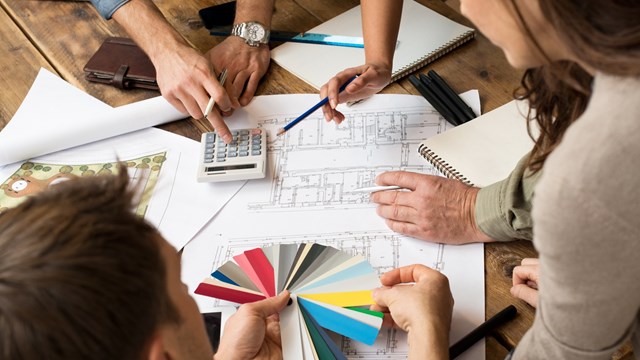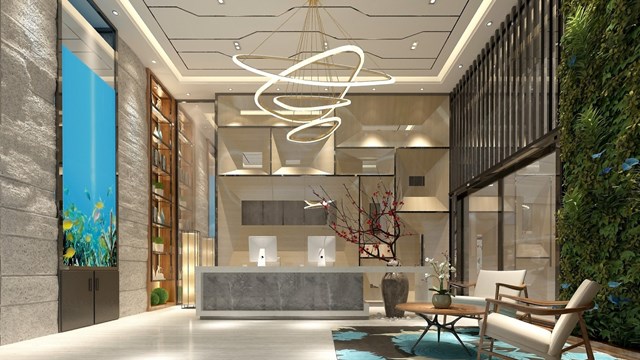
As issues such as global warming, shrinking rain forests and overflowing landfills move to the top of our national agenda, environmental considerations have taken a higher priority among interior designers as well. These days, a kitchen renovation can't just tuck a small garbage receptacle beneath the sink; bulky recycling containers have to be accommodated. And concerns about air quality and toxic substances from lead paint to floor finishes are commonplace. Today's designer should be equipped to answer questions and solve problems that take the environment into account, a service their clients have come to expect.
Efficient Design
Energy conservation is a concern that goes back decades, stemming from our dependence on foreign oil. These days, however, more can be done to save energy and protect our environment than simply turning off the lights when you leave the room. Your designer should be recom-meding these environmentally-friendly changes during any renovation job.
While the rewards of using more energy-efficient lighting, such as fluorescents, might seem obvious, there are other rewards. Some light bulbs generate more heat than others, which, in the summer, means a greater burden is put on your air conditioning system. Reducing air conditioning demand in your home not only helps your pocketbook but also reduces your overall use of electricity.
Your designer can suggest other tips for energy conservation. Ceiling fans, which can be visually atmospheric, can also increase your air conditioning's efficiency by circulating cooled air during those hot summer days. In the winter, the rotation of the blades can be reversed to push rising hot air down towards floor level, thereby aiding your heating system.
Although quite common in other areas of the country, recycling of glass, plastic, metals and newspapers is only now becoming commonplace in New York City. Of course in an urban environment like ours, it is more difficult to accommodate than elsewhere, if only because space is at such a premium. Should a renovation of your living space be plannedespecially changes to the kitchenincorporating an area for appropriate recycling containers is a wise move. Making recycling easy is the best way to ensure compliance (and avoid big fines) because for most of us there are always reasons why we can't be bothered as long as it is much easier to just throw it all in the garbage.
Designing For Your Health
As we have become more and more concerned about conserving energy, our homes and buildings have become tighter and tighter in terms of air infiltration. While the result is often lower energy bills, there is also a less frequent exchange of inside air for outside air, resulting in a concentration of potentially noxious fumes inside. I've seen some research that shows that air quality inside homes today is often worse than it is outside. The government addresses outside air quality but no one, so far, monitors indoor air quality in residential or commercial buildings.
Many of the indoor air quality problems are caused by materials used in the furniture and finishes we live with. For instance, formaldehyde-based products, such as particleboard, give off gasses which are noxious to some people. In apartments, as in office buildings, fumes generated by renovations or other work occurring in one part of the building can be circulated throughout the building via the central air conditioning or heating system. Keeping these systems adequately filtered and clear of build-up can reduce air quality problems.
Allergies play a large role in some people's reactions to the odors, gasses and particles in the air. If your designer does not ask, it is wise to volunteer any information you may have about your family's environmental sensitivities or allergies. Carpeting, floor coverings, the mastic that's used to put the carpet or floor covering down, the underlayment beneath your carpet, certain textiles, paints, dyes and cleaning solutions are among the materials that exude chemicals that can create problems, especially for sensitive or allergic people. Your designer should be able to advise you about substitutes for each of these that will not cause problems.
This is a constantly evolving field, with new formulations being produced regularly, so recommendations will change from time to time as new products are created and other problems are identified. I was amazed to discover that the permapress finish on bedroom sheets can trigger allergies as well as the synthetic materials used in many mattresses.
Forest Friendly
Another issue is the use of rare and exotic woods from rainforests, such as Rosewood, which is commonly used in the construction of dressers and desks. Many designers will not specify such woods on principle, feeling that if the demand for such products is diminished or eliminated, then the problem of rainforest destruction will go away. Personally, I believe that the destruction of the rainforest will continue as long as the residents of those areas are searching for income. A better solution is to teach forestry management to the people so they learn to reforest and perpetuate the value of the forested land. In the meantime, it is the designer's responsibility to find out the source of any exotic woods they are using and make sure they are coming from managed lands.
Many people have a general concern with environmental issues. But for those who do not, designing for the environment can be justified on a cost basis. More expensive light fixtures or bulbs are cheaper in the long run because they draw less power and put out less heat. The cost of the installation of special air conditioning filters or ceiling fans will be offset by lower heating and air conditioning expenses. And the purchase of newer, less toxic materials will lead to lower medical bills as allergies recede or disappear among those who are prone.
A knowledgeable and resourceful designer can be a vaulable ally for clients who want to idenfity the best path to take through this complex web of materials, products and systems. It should not be assumed, however, that accommodating these environmental issues means giving up elegant spaces. On the contrary, incorporating such issues can only enhance your designer's creativity and be beneficial for clients in the end.






Leave a Comment